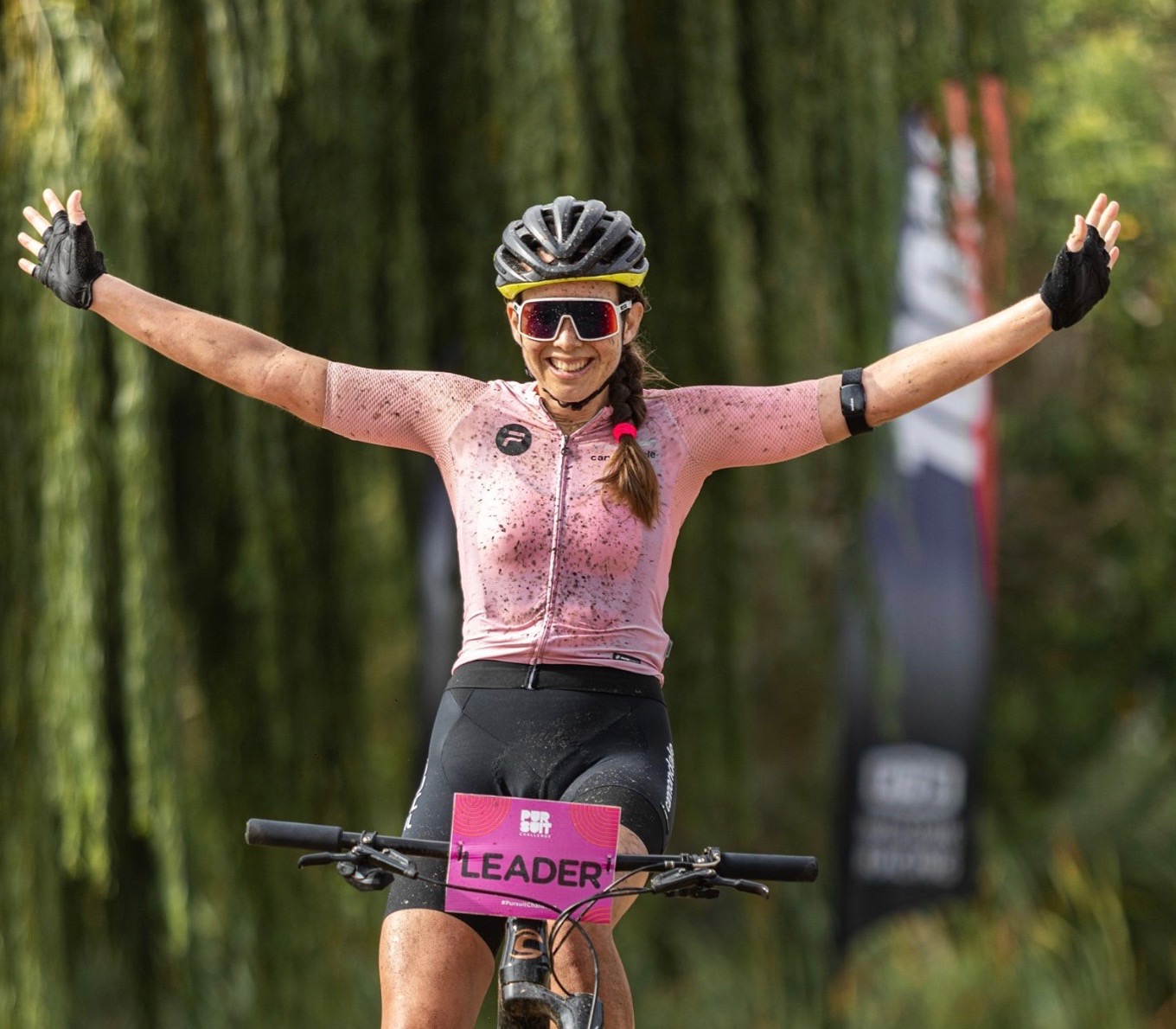Candice Lill will represent South Africa in the women’s mountain bike Cross-country (XCO) at the Tokyo Olympic Games on Tuesday 27 July. It’s nine years since her first Olympic Games (almost a third of her life ago!) and she’s grown immensely as a rider and person. We caught up with her to find out more about her preparation, expectations, bike and why she was dramatically delayed getting to Tokyo.
By Sean Badenhorst
Candice Lill (nee Neethling) was the final finisher in 28th place at the London Olympic Games. She had won the bronze medal at the 2009 Junior XCO World Champs and was starting to build a foundation for a bike racing career. Instead of sending no women, South Africa, which had secured a spot via the ‘soft’ African continental route, decided to send Lill to gain experience.
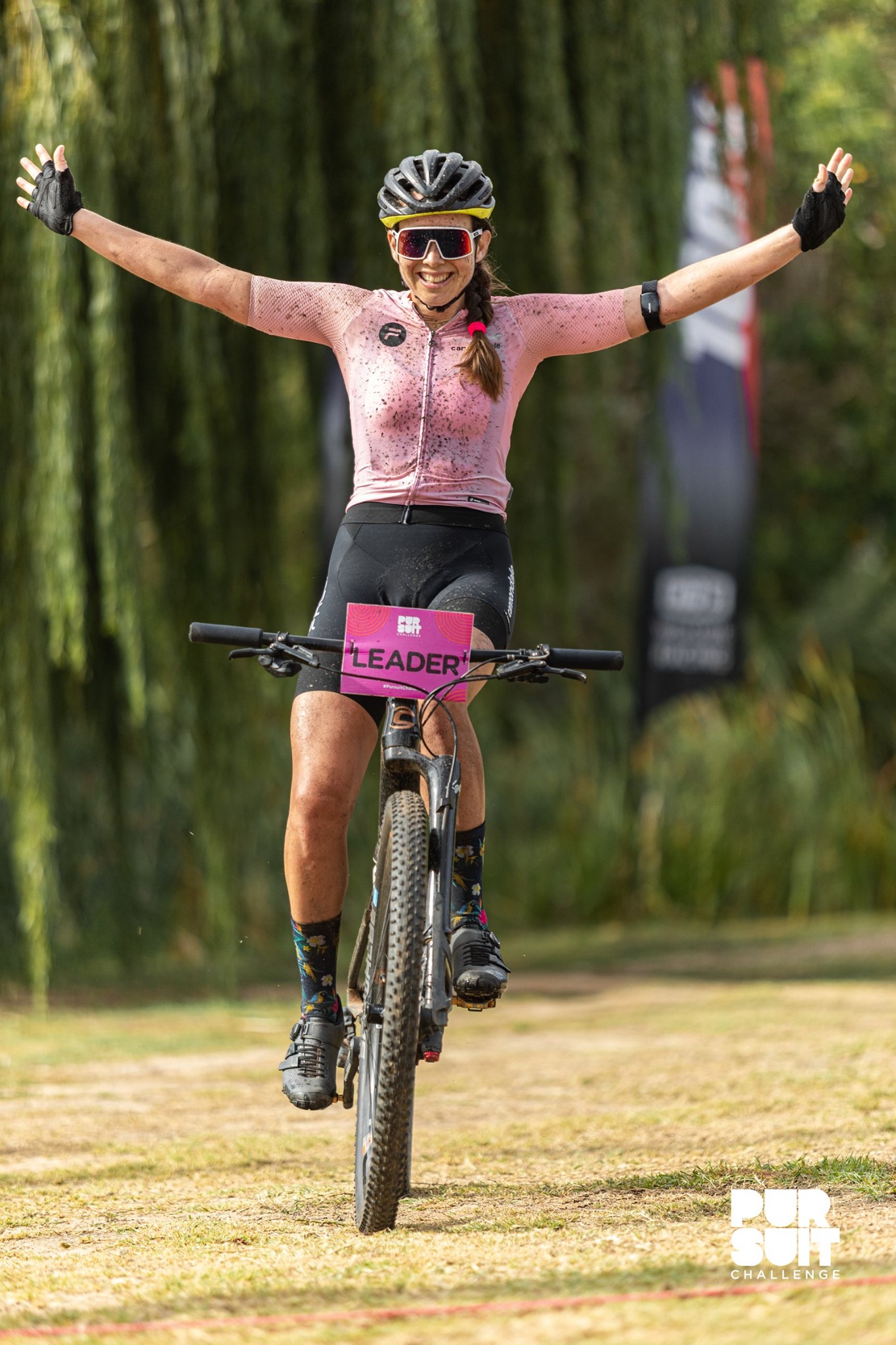
Candice Lill winning Round 4 of the Pursuit Challenge. Photo: Pursuit Challenge
Two riders, including the sport’s greatest racer, Gunn Rita Dahle Flesjaa, did not finish that day. France’s Julie Bresset won the gold medal and a weary Lill rolled across the finish line 14 minutes and 11 seconds later. She was clearly spent, but still managed a smile. It was a challenging course and she had managed to avoid being lapped.
Now, nine years later, Lill faces her second shot at the Olympic Games. She won a three-way battle with Mariske Strauss and Cherie Redeker to be selected for the one place earned by South Africa’s UCI nation ranking for Tokyo. Just the fact that three women have been consistently racing internationally and earning UCI points for South Africa over the past few years shows how far the sport has come.
It wasn’t an easy choice for Cycling South Africa to make, but they opted for Lill to fill the Tokyo spot and since then the 29-year-old Capetonian has been hard at work preparing for one of the biggest days of her bike-racing life. We made contact with her in Tokyo, four days before her race.
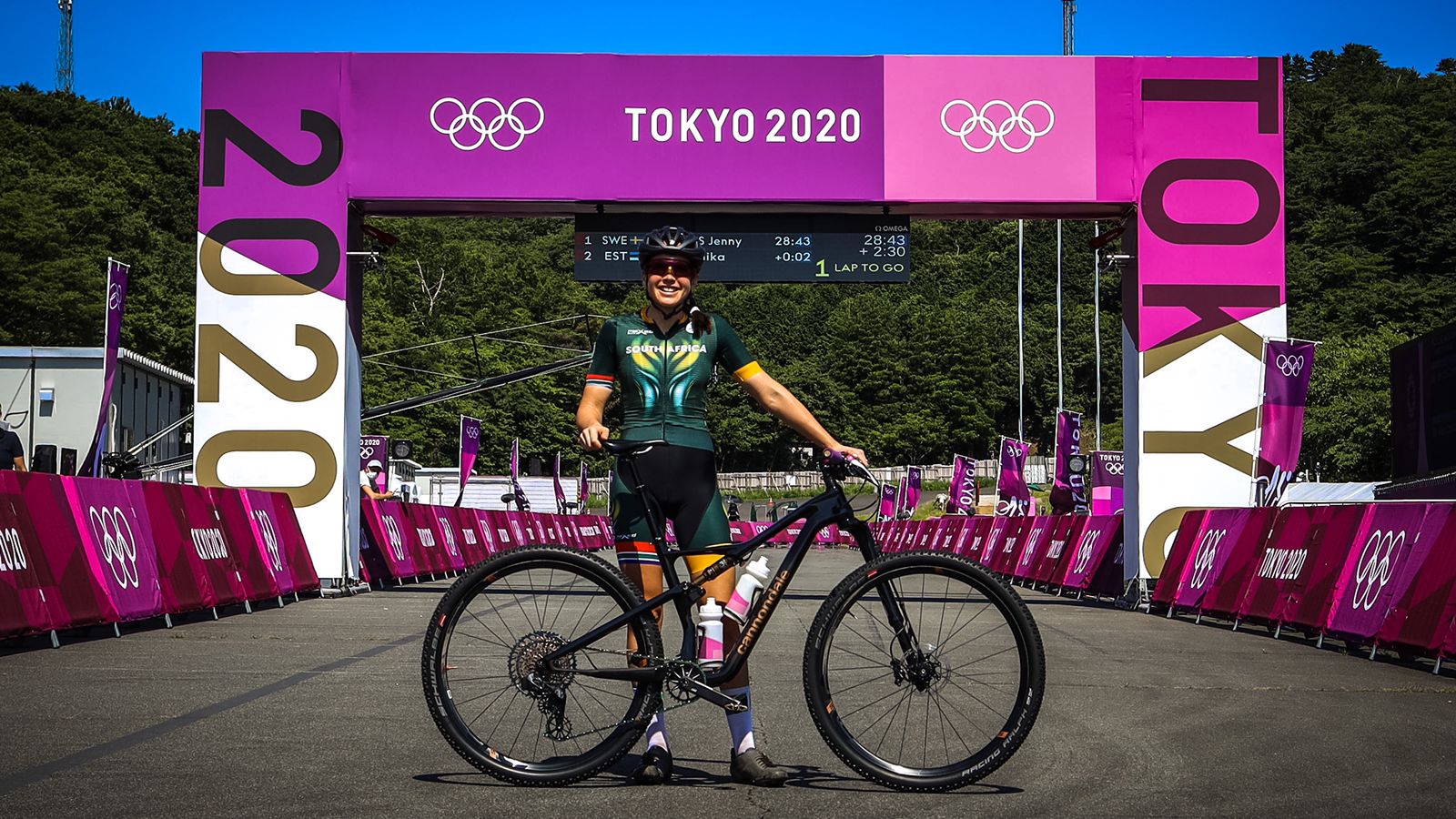
A confident Lill poses at the mountain bike venue in Tokyo.
You opted to fine tune for the Games at home, which obviously is a more stable environment. How have the last few weeks been in this regard – are you in peak form?
After a few weeks of racing in Europe in May and June, which is where I heard I’d been selected for Tokyo, the options were to stay in Europe and try race more in summer climate or come home to do the final preparation in winter climate. I really wanted to come home to a more stable environment. I knew there was some specific preparation I needed to do because of the obstacles on the Tokyo course. I spoke to Nick Floros, the South African that designed the Tokyo course and got an idea of what to expect. So Darren, my husband, built quite a big wooden drop-off at home for me to practice on. I was also able to do many really good training sessions on familiar roads and trails. We have a lot of variety in Cape Town and I needed to build my confidence on rocks, which I was also able to do in Tokai.
The Olympic course is technically challenging with short climbs. Do you feel this suits you?
I actually rode the course for the first time today (Friday) and it’s very, very busy! Technical downhills with quite short, steep and punchy climbs. I don’t think I have ever raced a course like this. A lot of the courses in Europe have longer climbs and in South Africa we have a bit of a mix. This really is going to be quite challenging. It’s one thing to ride it, but to race it is going to be tough. I think those climbs are going to be quite brutal. The steepness and effort you need to put in just to get up them is maximum! Then to follow that up by coming into a technical section that is pretty gnarly with your heart rate through the roof… It’s going to be hard. I don’t really know if this kind of course suits me. What would suit me is if it stays dry. It’s dusty, dry and rocky currently, which is what most of our South African courses are like.
My first practice lap was really scary, to be honest, but also very rewarding! There’s two big main rock gardens, which have some crazy things you have to roll off, which is quite intimidating. Fortunately I have been doing quite a lot of mental strength strategies and visualisation so was able to calm down and roll down. But let me tell you at the end of that first rock garden the first time my adrenaline was through the roof! But then there was such a feeling of relief and reward when I was able to do it. I was in a really good space today and I was able to ride all the A Lines first time. It was scary, but that’s why we love mountain biking, right?
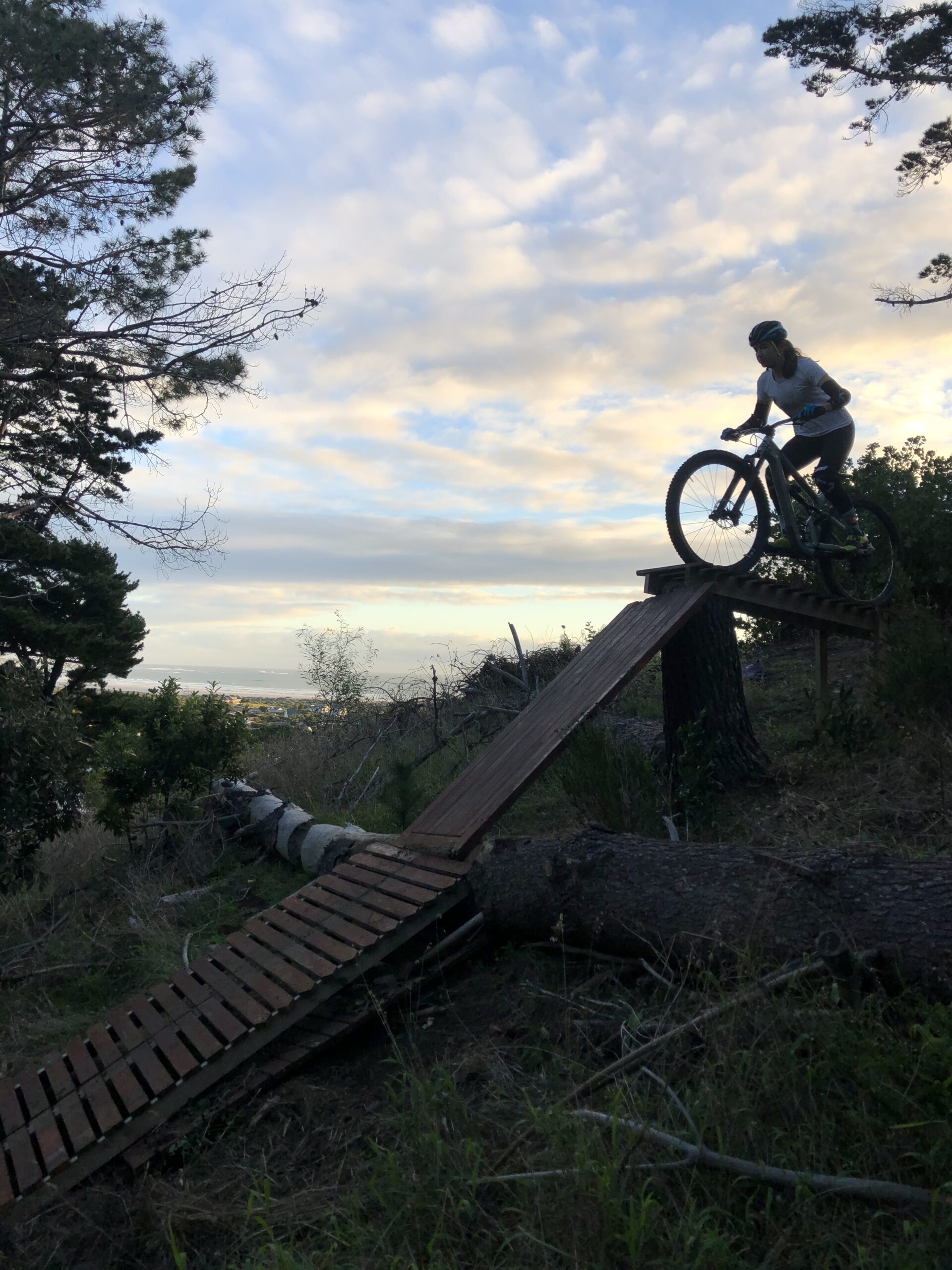
Lill during early practice on the drop-off her husband built at their home in Cape Town.
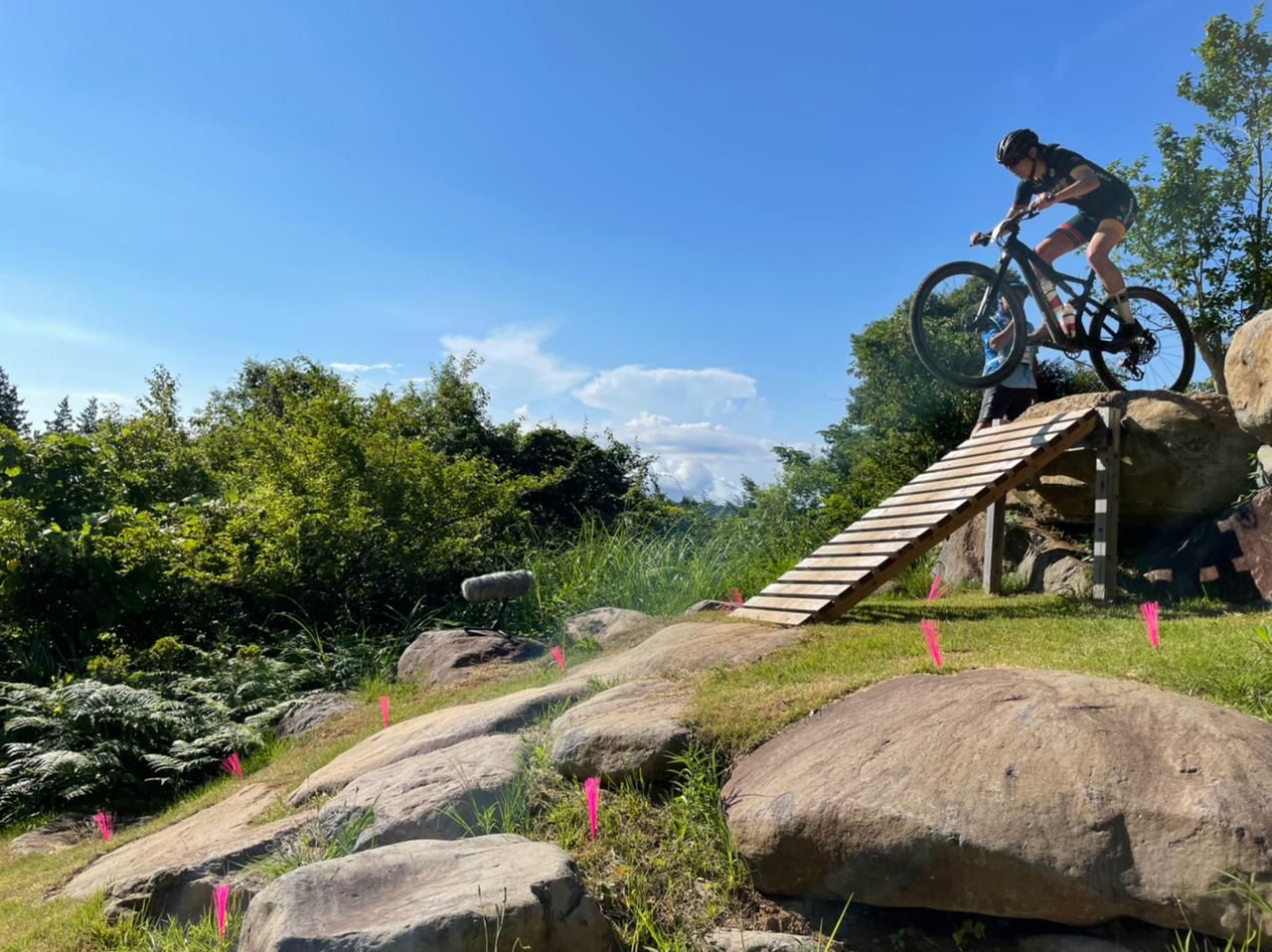
Lill smashing one of the Olympic drop-downs during practice.
We noticed Darren built a big wooden drop-off for you to ride during training. It looks quite intimidating. Did this help you grow your confidence?
It has been such a big help. It immediately changed my perspective. Before practising that drop-off a lot I would have said that drop-offs were one of my weak points. Not from a skills perspective but more because I was irrationally afraid that I might crash and hurt myself a lot. But having done that drop-off at home so much – I probably rode it a hundred times – any drop-off looks pretty small to be honest. I can’t believe how much it helped. It just goes to show that for me, it was definitely a mental thing. To have that perspective now has been so helpful on this course. There’s one big main drop-off, but there’s also lots of awkward, smaller drop-offs that are still scary. If I hadn’t had that drop-off at home to practice on, I would have even been afraid of the smaller ones. So I’m feeling so happy about my progress.
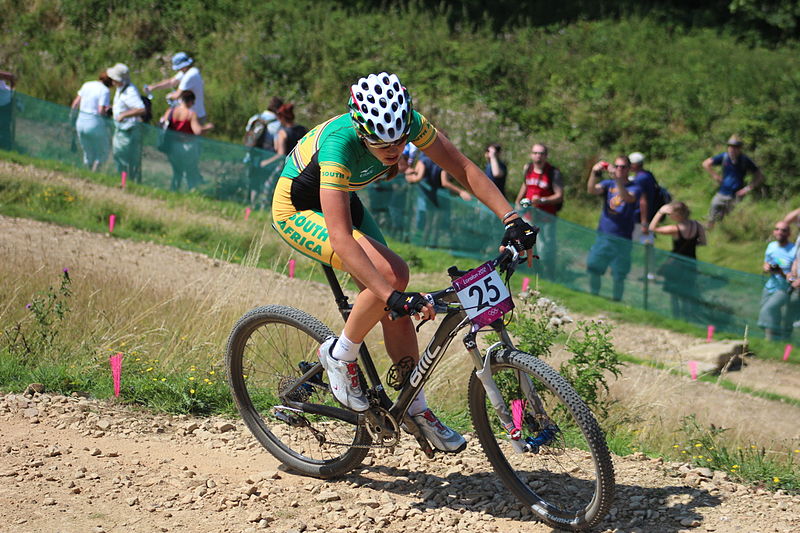
Candice (then Neethling), competing at the London Games in 2012. | Photo Steve Fair
As a youngster, you competed at the London Olympics in the Women’s XCO. You were chosen based on the experience you would gain. Obviously with Covid, the Tokyo Games will be quite different, but there is something really cool about the Olympic experience for athletes. Will you have to leave after your event or can you stay longer to have that experience?
Being here in Tokyo has made be reflect on my London experience, which I haven’t thought about in years. That was a long time ago. I don’t remember that much about it. I think I was very overwhelmed, immature and lacking confidence. Over the last nine years I’ve grown a lot in those areas. I am able to come to Tokyo with a clear mind and just confidently approach everything, which gives you the space to absorb the experience a bit more. But I think maybe having done the London Games, as much as I don’t recall a lot of the experience, maybe that is the experience. Maybe the first one is always going to be overwhelming and scary and now I’m able to come here and focus on the race and also enjoy everything that the Olympics is. It’s been wonderful so far. Really special. Everyone is so happy to be here, especially during this unpredictable Covid time.
Because everyone that you are competing against is staying together and eating together and taking the bus together to the course, we interact a lot more that we would at the World Cups. It’s been a really positive, friendly experience. I have made a new friends with people I wouldn’t normally interact with. It’s something special that I will remember for a long time.
We can’t say longer because of Covid. We are very restricted by where we go. I leave the day after my race to go home, which is really unfortunate. To come all the way to Japan and not see it. I would have loved to spend a week here afterwards. We’ll just have to come back, it is a beautiful country.
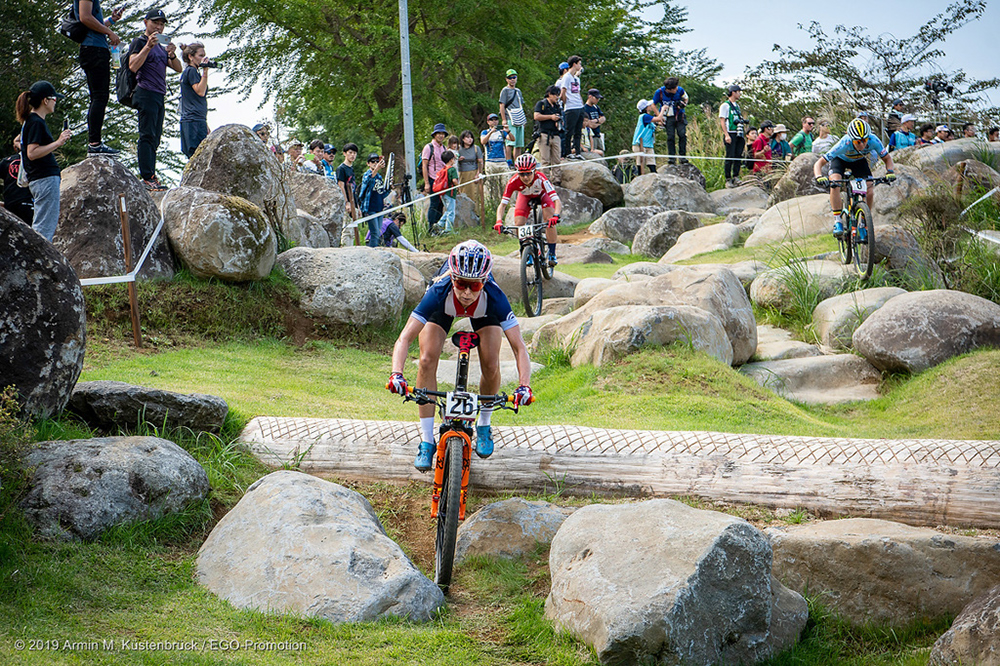
The Tokyo Games course is full of challenging sections including two huge rock gardens. | Photo: Tokyo Test Event.
What is your personal objective for the Tokyo race?
I am not going to put any kind of finishing position as a personal objective. One of my big objectives was to come here and be able to ride the course confidently. I had heard the course was going to be hectic so being able to race the whole course with no problems will be my first objective. I just want to have a race I can be proud of. If I have a bad start, I want to overcome that. I want to stay positive, not give up. It’s like focussing on the process and the moment and being able to execute in every moment and remain positive throughout. I want to race with fire and heart and all the motivation that I have coming into this. I want my performance in the race to be reflective of what I am capable of, doesn’t matter what position that may be.
Apparently it’s very hot and humid in Tokyo. How have you conditioned yourself for that in cold, rainy Cape Town?
In Cape Town I built up sauna time over the past few weeks, alternating with riding on the indoor trainer with a heater. Starting with 20 minutes and building up to 45 minutes. I think that has made a difference.
Anything special about your Cannondale Scalpel?
There are a few special touches on my Cannondale Scalpel. The colour of this model for 2021 is black so I decide to accessorise it with some colour. All the bolts on my bike are oil slick (so rainbow colours), made by Kogel. Also my jockey wheels are bigger and from Kogel. I have some purple ESI grips. I ride Schwalbe tyres and at the moment I have a Racing Ray on the front and a Racing Ralph at the back. It’s dry and sketchy so that tyre combo offers really good grip. I also have an 80mm dropper seatpost from Bike Yoke. I love it! I would not be able to ride this course without it. It definitely helps you get your body position right and gives you more confidence.

Who do you feel are the likely medal contenders for Tokyo?
In the men’s race I really hope that Alan (Hatherly) gets a medal. I believe he can. In the women’s race, I would say Leona Lecomte, Pauline Ferrand Prevot, Jenny Risveds and Evie Richards are the medal contenders.
It’s one thing qualifying and being selected for Tokyo, but it seems that actually getting to Tokyo has been a serious challenge!
Nobody could ever have prepared me for the journey to just get to the Tokyo Olympics! It’s been a huge mission. A lot of admin and paperwork and apps have been involved. The immigration has been extremely strict. Every day here you’ve got to do a PCR test, take your temperature and complete a questionnaire all through this app, which is linked to the Japanese government. After two 10-hour flights and a layover, it took about four hours to get through the airport protocols when I arrived here. They are so strict with everything. Then I had a three-hour bus trip after that.
I arrived here two days later than planned because of complications with my PCR test result at home. Luckily, through SASCOC and the medical team, I was eventually cleared to come. The PCR test in South Africa was positive, but it was from an old infection. It was basically unlucky that they found one piece of old genetic residue left from an old infection. I had to do all kinds of checks and blood tests and then another three more negative PCR tests, which as you can imagine was all quite a process and very stressful. Luckily I passed all that. I feel relieved to be here! Nothing can surprise me anymore and I think it’s reflecting in the way that I’m approaching the race, the course and the event. I’ve been through a lot to get here. I’m really proud to be here and I want to make myself and South Africa proud, especially the women who mountain bike back home.
The women’s XCO race will be shown live on SuperSport TV in South Africa on Tuesday 27 July at 07h55.


